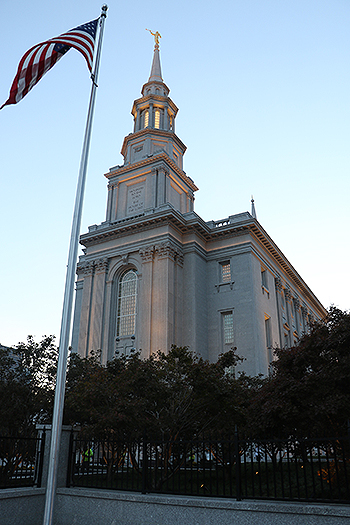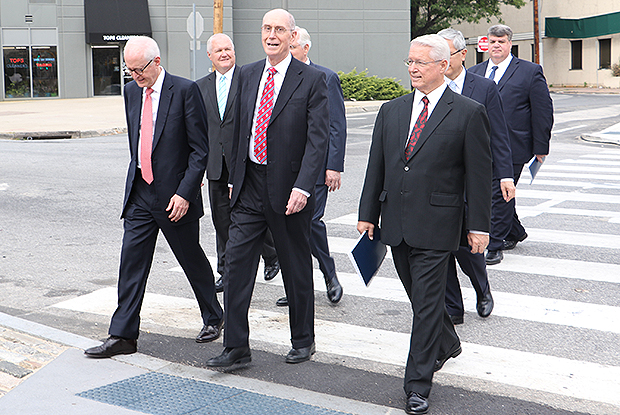President Eyring Dedicates Temple in Philadelphia, “Where So Much Began”
Contributed By Sarah Jane Weaver, Church News associate editor

President Henry B. Eyring, First Counselor in the First Presidency, at right, and Elder D. Todd Christofferson of the Quorum of the Twelve Apostles stand in front of the Philadelphia Pennsylvania Temple on September 17, 2016.
Article Highlights
- New temple located in the heart of the City of Brotherly Love represents not only history but also Church growth.
“To me it is a wonderful place to have a temple of God, where we have a feeling of God’s hands in our lives, where we make promises to a God who has looked over this nation.” —President Henry B. Eyring of the First Presidency
Related Links
Not too many years ago, President Henry B. Eyring returned to the small rock chapel in Philadelphia where he was baptized a member of The Church of Jesus Christ of Latter-day Saints. He studied the mural of Lehi’s dream, still gracing the building. Then, as he walked down the old stairway that led to the baptistry, he remembered the feelings he had there as a child.
“That is where so much began,” President Eyring, First Counselor in the First Presidency, told the Church News. The Church in the area “was so small then. Yet now we have a temple of God in one of the most prominent places in Philadelphia.”
Threads of American history, Church history, and President Eyring’s personal history come together in Philadelphia—weaving a beautiful tapestry that was completed when the Church leader dedicated the Philadelphia Pennsylvania Temple on September 18.
For President Eyring, a beautiful new temple, located in the heart of the City of Brotherly Love, represents not only history but also growth. “I can’t believe what the Lord has done, not just in having the temple, but what it represents in the strength of the Church,” he said.
During President Eyring’s youth, he gained a deep appreciation for the rich history of this area.
Born in Princeton, New Jersey, a young Hal Eyring would entertain his family’s out-of-town guests with tales of the Revolutionary War. The pivotal Battle of Princeton took place not far from the Eyring home. Walking with visitors across the campus of Princeton University—where his father worked as a science professor—Hal would recount Revolutionary War battles; in Nassau Hall, he would explain, a cannonball came crashing through the window, decapitating a prominent portrait, but leaving the frame intact to later house a painting of George Washington.

Philadelphia Pennsylvania Temple. Photo by Sarah Jane Weaver.

President Henry B. Eyring, First Counselor in the First Presidency, participates in the cornerstone ceremony of the Philadelphia Pennsylvania Temple on September 18, 2016. Photo by Sarah Jane Weaver.

President Henry B. Eyring, First Counselor in the First Presidency, participates in the cornerstone ceremony of the Philadelphia Pennsylvania Temple on September 18, 2016. Photo by Sarah Jane Weaver.

President Henry B. Eyring, First Counselor in the First Presidency, participates in the cornerstone ceremony of the Philadelphia Pennsylvania Temple on September 18, 2016. Photo by Sarah Jane Weaver.

President Henry B. Eyring, First Counselor in the First Presidency, waves to the crowd after participating in the cornerstone ceremony of the Philadelphia Pennsylvania Temple on September 18, 2016. Photo by Sarah Jane Weaver.

Joseph Smith organized the first branch in Philadelphia on December 23, 1839. A few weeks after the branch was organized, Joseph Smith, Sidney Rigdon, Orson Pratt, and Parley P. Pratt participated in a conference in the city, held in a large building—where an original window still remains—and attended by 3,000 people. Those in attendance said Joseph “arose like a lion about to roar” and spoke with great power. Photo by Sarah Jane Weaver.
With his family, President Eyring visited Valley Forge, the American Revolutionary War winter encampment; recapped the miracle of the Battle of Trenton, the site in which George Washington led his troops to victory after crossing the icy Delaware on Christmas Day 1776; and stood where the Continental Congress met and issued the Declaration of Independence.
The Founding Fathers of the United States gave so much for this country, said President Eyring. These men, in the very place the Lord has built a temple, created, “under the inspiration of God,” a governmental structure that allowed for freedom of religion.
Today the temple, he said, represents the hand of God in Philadelphia, “as it must have been once as the country was founded.”
The miracles witnessed by the Founding Fathers as they worked to establish the documents of American freedom are proof this nation will survive into the future, said President Eyring.
“[The Lord] preserved it in the battle of Princeton; He preserved it in Valley Forge. To me it is a wonderful place to have a temple of God, where we have a feeling of God’s hands in our lives, where we make promises to a God who has looked over this nation, and where, as we make covenants, God will look over our lives and the lives of our descendants.”
Completed at great personal sacrifice, the work of the Founding Fathers made it possible for the Restoration of the gospel of Jesus Christ to take place, said President Eyring.
Also of great and sacred importance to the area are the important events of Church history that occurred in Pennsylvania, he said.
The Prophet Joseph Smith met and married Emma in Harmony, where Joseph began in earnest translating the Book of Mormon and the priesthood was restored. On May 15, 1829, Joseph Smith and Oliver Cowdery were baptized in the Susquehanna River, about 150 miles north of Philadelphia.
Among the many early Church leaders to visit and preach in Philadelphia was Joseph Smith, who, on his 34th birthday, organized the first branch in the city on December 23, 1839.
Reading the exact words from Church history, President Eyring explained that a few weeks after the branch was organized, Joseph Smith, Sidney Rigdon, Orson Pratt, and Parley P. Pratt participated in a conference in Philadelphia.
Leaders opened a large building for Joseph to preach in, and 3,000 people gathered to hear him speak. Joseph “arose like a lion about to roar” and spoke with great power. Not far from the current location of the Philadelphia Temple, Joseph proclaimed his testimony of the First Vision and the Restoration of the gospel of Jesus Christ.
After Joseph’s death when early members moved west, many LDS converts made their way to Zion though Philadelphia.
The first LDS chapel in the city was dedicated decades later on May 22, 1938. The Philadelphia Stake was organized 22 years after that on February 16, 1960.
President Eyring broke ground for the Philadelphia Pennsylvania Temple on September 17, 2011. The date marked Constitution Day—an observance that recognizes the day in 1787 that delegates to the Constitutional Convention signed the United States Constitution.
Now—just over 240 years after members of the Second Continental Congress assembled in the city to sign and adopt the Declaration of Independence—President Eyring dedicated the Philadelphia Temple.
A temple “is a place of connection in history,” he said. “You participate in ordinances and make covenants, and you are allowed to reach back to your ancestors and you make covenants that will bless your descendants.”
When President Eyring thinks of the temple, he can’t help but recall the feelings he had as a child.
He remembers the trip in the back seat of his family’s ’37 Ford from Philadelphia to his home in Princeton after becoming a newly baptized member. Even at age eight, he understood the weight of the baptismal covenant he had just made.
And President Eyring remembers with clarity the years before and after his baptism as he gathered with his family and a handful of others for Church services in the dining room of his family home.
“It doesn’t take a building; I felt the Holy Ghost in that dining room as much as if in the finest chapel. It was the people. If they have faith, the Holy Ghost comes.“

President Henry B. Eyring was baptized a member of The Church of Jesus Christ of Latter-day Saints in the small rock chapel. Photo by Sarah Jane Weaver.

Joseph Smith organized the first branch in Philadelphia on December 23, 1839. A few weeks after the branch was organized, Joseph Smith, Sidney Rigdon, Orson Pratt, and Parley P. Pratt participated in a conference in the city, held in this church building and attended by 3,000 people. Those in attendance said Joseph “arose like a lion about to roar” and spoke with great power. Photo by Sarah Jane Weaver.

President Henry B. Eyring, First Counselor in the First Presidency, crosses the street near the Philadelphia Pennsylvania Temple on September 17, 2016. Photo by Sarah Jane Weaver.

Philadelphia Pennsylvania Temple. Photo by Sarah Jane Weaver.
